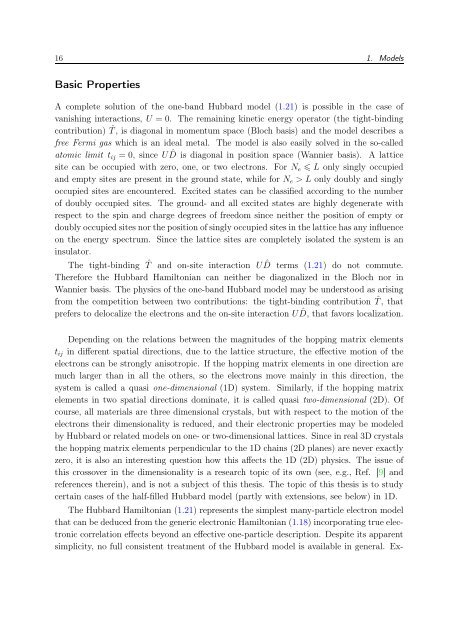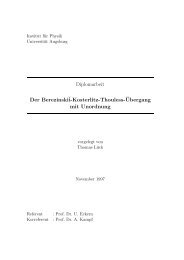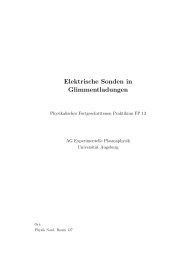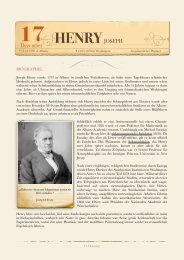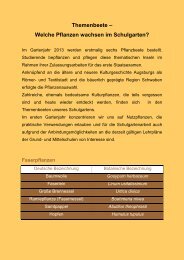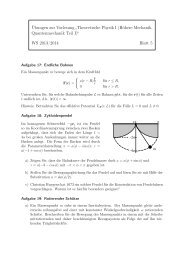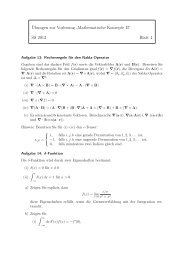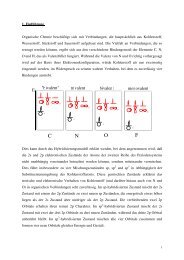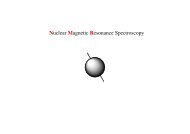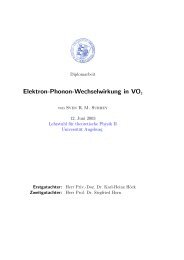PhD Thesis - Universität Augsburg
PhD Thesis - Universität Augsburg
PhD Thesis - Universität Augsburg
You also want an ePaper? Increase the reach of your titles
YUMPU automatically turns print PDFs into web optimized ePapers that Google loves.
16 1. Models<br />
Basic Properties<br />
A complete solution of the one-band Hubbard model (1.21) is possible in the case of<br />
vanishing interactions, U = 0. The remaining kinetic energy operator (the tight-binding<br />
contribution) ˆT, is diagonal in momentum space (Bloch basis) and the model describes a<br />
free Fermi gas which is an ideal metal. The model is also easily solved in the so-called<br />
atomic limit t ij = 0, since U ˆD is diagonal in position space (Wannier basis). A lattice<br />
site can be occupied with zero, one, or two electrons. For N e L only singly occupied<br />
and empty sites are present in the ground state, while for N e > L only doubly and singly<br />
occupied sites are encountered. Excited states can be classified according to the number<br />
of doubly occupied sites. The ground- and all excited states are highly degenerate with<br />
respect to the spin and charge degrees of freedom since neither the position of empty or<br />
doubly occupied sites nor the position of singly occupied sites in the lattice has any influence<br />
on the energy spectrum. Since the lattice sites are completely isolated the system is an<br />
insulator.<br />
The tight-binding ˆT and on-site interaction U ˆD terms (1.21) do not commute.<br />
Therefore the Hubbard Hamiltonian can neither be diagonalized in the Bloch nor in<br />
Wannier basis. The physics of the one-band Hubbard model may be understood as arising<br />
from the competition between two contributions: the tight-binding contribution ˆT, that<br />
prefers to delocalize the electrons and the on-site interaction U ˆD, that favors localization.<br />
Depending on the relations between the magnitudes of the hopping matrix elements<br />
t ij in different spatial directions, due to the lattice structure, the effective motion of the<br />
electrons can be strongly anisotropic. If the hopping matrix elements in one direction are<br />
much larger than in all the others, so the electrons move mainly in this direction, the<br />
system is called a quasi one-dimensional (1D) system. Similarly, if the hopping matrix<br />
elements in two spatial directions dominate, it is called quasi two-dimensional (2D). Of<br />
course, all materials are three dimensional crystals, but with respect to the motion of the<br />
electrons their dimensionality is reduced, and their electronic properties may be modeled<br />
by Hubbard or related models on one- or two-dimensional lattices. Since in real 3D crystals<br />
the hopping matrix elements perpendicular to the 1D chains (2D planes) are never exactly<br />
zero, it is also an interesting question how this affects the 1D (2D) physics. The issue of<br />
this crossover in the dimensionality is a research topic of its own (see, e.g., Ref. [9] and<br />
references therein), and is not a subject of this thesis. The topic of this thesis is to study<br />
certain cases of the half-filled Hubbard model (partly with extensions, see below) in 1D.<br />
The Hubbard Hamiltonian (1.21) represents the simplest many-particle electron model<br />
that can be deduced from the generic electronic Hamiltonian (1.18) incorporating true electronic<br />
correlation effects beyond an effective one-particle description. Despite its apparent<br />
simplicity, no full consistent treatment of the Hubbard model is available in general. Ex-


